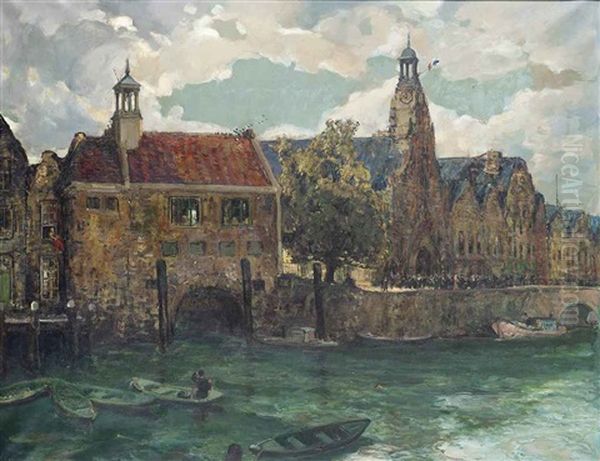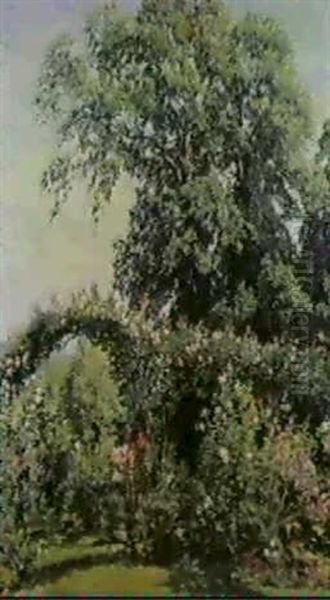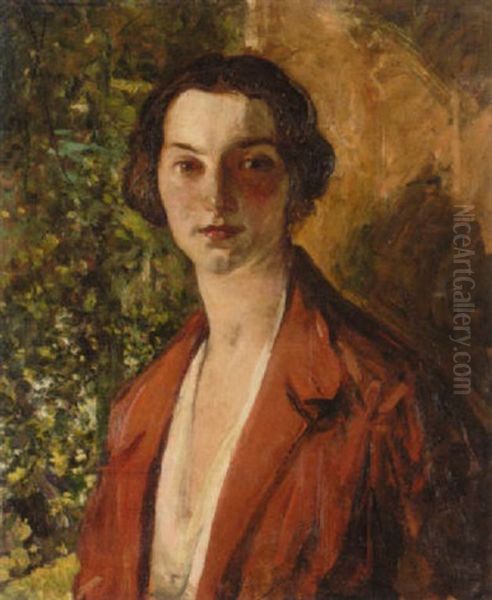Alexander Jamieson, born in Glasgow, Scotland, in 1873, stands as a significant figure in the landscape of early 20th-century British art. A painter deeply rooted in the Impressionist tradition, his life and work offer a fascinating glimpse into the adaptation and evolution of this revolutionary French style within a Scottish context. Spanning a career that saw him move from the industrial heartland of Glasgow to the artistic hub of Paris, and finally to the quiet English countryside, Jamieson developed a distinctive voice, celebrated primarily for his evocative landscapes rendered in oil, watercolour, and sketch. His death in 1937 marked the end of a dedicated artistic journey, leaving behind a legacy of works that continue to resonate with their sensitivity to light, colour, and atmosphere.
Early Life and Artistic Formation
Jamieson's artistic journey began in his native Glasgow, a city burgeoning with industrial might but also fostering a vibrant cultural scene. He enrolled at the prestigious Glasgow School of Art, then known as the Haldane Academy. This institution was already gaining a reputation, partly thanks to the burgeoning success of the "Glasgow Boys," a group of artists like James Guthrie and E. A. Walton who were challenging traditional academic painting, often looking towards French realism and naturalism. While Jamieson's later style would lean more towards Impressionism, his initial training in Glasgow provided a solid foundation in draughtsmanship and composition.
A pivotal moment in Jamieson's development came with his decision to further his studies in Paris. He spent a year in the French capital, immersing himself in its unparalleled artistic environment. This was the crucible where Impressionism had been forged decades earlier by masters such as Claude Monet and Camille Pissarro, and where Post-Impressionist ideas were now taking hold with artists like Paul Cézanne and Georges Seurat. The exposure to French art, particularly the works of the Impressionists and earlier landscape painters like Jean-Baptiste-Camille Corot, profoundly shaped Jamieson's aesthetic sensibilities.
The Influence of Impressionism

The time spent in Paris was transformative. Jamieson absorbed the core tenets of Impressionism: the emphasis on capturing the fleeting effects of light and atmosphere, the use of a brighter palette, and the application of paint in broken, visible brushstrokes. He became particularly adept at the alla prima or wet-in-wet technique, favoured by many Impressionists for its immediacy and ability to blend colours directly on the canvas, creating vibrant and luminous effects. This technique would become a hallmark of his style.
His influences, as reflected in his work and noted by observers, included not only the high Impressionists like Monet but also figures who bridged Realism and Impressionism, such as Édouard Manet and Corot. Manet's bold compositions and modern subjects, along with Corot's sensitive tonal landscapes, likely resonated with Jamieson. While one source mentions Wassily Kandinsky as an influence, this seems less direct for Jamieson's core Impressionistic style, as Kandinsky was a pioneer of abstract expressionism; perhaps it reflects a broader awareness of contemporary European art movements rather than a specific stylistic debt in his landscape work. Jamieson synthesized these influences into a personal style characterized by fluid brushwork and a keen observational eye.
Artistic Style and Techniques
Alexander Jamieson's art is predominantly associated with Impressionism, specifically landscape painting. His approach involved capturing the essence of a scene, often focusing on the interplay of light and shadow across natural forms. He possessed a remarkable ability to convey the mood and atmosphere of a place, whether it be the gentle hills of Buckinghamshire, the formal gardens of Versailles, or the bustling waterways of Rotterdam.
His technique often involved making initial sketches outdoors, directly observing his subject en plein air, a practice central to Impressionism. These studies would then inform larger compositions completed in the studio. This combination allowed for both spontaneity and considered refinement. The resulting works often retain a sense of immediacy, described by some as having a "painterly sketch" quality, where the energy of the brushstroke remains visible and contributes to the overall vitality of the image. His palette was rich and varied, capable of capturing the subtle greens and blues of a summer pond or the stark contrasts of a winter scene.
Themes and Subjects
Landscape was Jamieson's primary passion. His oeuvre is rich with depictions of the natural world and the built environment within it. Having settled later in life in Weston Turville, Buckinghamshire, the English countryside became a frequent subject. He painted the fields, farms, ponds, and reservoirs of his locality with affection and intimacy. Works depicting scenes around his home, Burnside, are particularly notable, showcasing his connection to his immediate surroundings.

Beyond the English pastoral, Jamieson's travels provided further inspiration. His time in France resulted in paintings of iconic locations like the gardens of the Palace of Versailles, capturing their grandeur and formal beauty through an Impressionist lens. His earlier work also includes townscapes and harbour scenes, such as his depiction of Rotterdam, demonstrating his ability to handle architectural subjects and bustling urban environments with the same sensitivity to light and atmosphere. While less frequent, Jamieson also undertook portraiture and figure painting, sometimes depicting local figures or, more intimately, members of his own family.
Notable Works: Capturing Moments in Time
Several key works exemplify Alexander Jamieson's artistic output and stylistic concerns. Sunday, Midday at Rotterdam, dated 1904 and held by the Royal Academy of Arts in London, is an early example of his engagement with continental European subjects. Likely depicting the city's canals or harbour, this painting showcases his ability to render complex scenes with vibrant light and fluid brushwork, characteristic of his Impressionist approach.
His fascination with gardens and structured landscapes is evident in works inspired by Versailles. A piece titled The Garden Landscape from 1922, and another described as Figures standing on a terrace at a palace believed to be Versailles, Paris from 1910, capture the unique blend of nature and human design found in such formal settings. These works allowed Jamieson to explore effects of sunlight filtering through trees and reflecting off water and statuary.
Notable Works: The Buckinghamshire Years
Jamieson's move to Weston Turville provided a wealth of local subject matter. The Artist’s Garden, painted around 1930 and now in the collection of the Bucks County Museum, depicts the rose arch and flower borders at his home, Burnside. It is a personal and charming representation of his domestic environment, rendered with characteristic Impressionist flair. The museum also holds Mill Farm in Winter (c. 1930) and Skating on Weston Turville Reservoir, both capturing seasonal aspects of local life and landscape, the latter offering a lively snapshot of community activity.
Our Pond, dated 1937, the year of his death, is a poignant late work, also depicting a feature of his Burnside home. Held at the Glasgow Museums Resource Centre, this painting serves as a quiet reflection on the familiar landscape that surrounded him in his final years. It embodies the culmination of his lifelong dedication to observing and interpreting the natural world through the lens of Impressionism.
Versatility: Beyond Pure Landscape
While primarily a landscape painter, Jamieson demonstrated versatility. His portrait The Artist's Wife, depicting his wife Gertrude (Biddy) MacDonald at breakfast, offers a glimpse into his personal life and his skill in figure painting. This work, likely painted with the same fluid brushwork as his landscapes, adds another dimension to his artistic personality.

Another notable work mentioned is Kitchener inspecting the 10th Battalion at Halton. This piece suggests an engagement with contemporary events or commemorative subjects, possibly related to World War I, although details about its specific context are limited in the provided sources. It indicates his capacity to tackle different genres when commissioned or inspired to do so, moving beyond the typical Impressionist focus on landscape and leisure.
Career Development and Recognition
Jamieson began exhibiting his work relatively early in his career. His debut exhibition at the Carfax Gallery in London marked an important step in establishing his reputation beyond Scotland. Throughout his career, he continued to exhibit, likely participating in shows at various institutions in London and perhaps Scotland.
Like many artists of his time, Jamieson found it necessary to supplement his income through teaching. He taught painting and ran summer schools, sharing his knowledge and passion with students. This pedagogical activity not only provided financial stability but also likely kept him engaged with evolving artistic ideas and practices. His move with his wife Biddy to Weston Turville established them within the local community, where they continued their artistic pursuits.
Context: Scottish Art and British Impressionism
Alexander Jamieson worked during a dynamic period in Scottish art. While the Glasgow Boys (like James Guthrie, E. A. Hornel, George Henry) had brought international attention to Scottish painting with their often bold, decorative, or naturalist styles in the late 19th century, Jamieson represented a more direct engagement with French Impressionism, akin perhaps to some aspects of the work of Arthur Melville, though Melville's technique was often watercolour-based and distinctively bold. Jamieson's commitment to landscape and the effects of light places him firmly within the Impressionist lineage adapted to a British context.
In Britain, Impressionism was adopted and adapted in various ways. Artists like Walter Sickert and Philip Wilson Steer were key figures associated with British Impressionism, though Sickert developed a darker, more urban-focused realism, while Steer experimented more broadly. Jamieson's work, with its consistent focus on landscape and relatively orthodox Impressionist technique, contributes to the story of how this French movement took root and flourished, albeit sometimes in modified forms, across the Channel. His Scottish origins and training, combined with his Parisian experience and English residency, make him an interesting bridge figure.
Wider European Artistic Context
To fully appreciate Jamieson's place, it's helpful to remember the broader European art scene. By the time Jamieson was active, Impressionism's first wave (Monet, Pierre-Auguste Renoir, Edgar Degas, Pissarro) had passed its peak revolutionary phase but remained hugely influential. Post-Impressionism, with figures like Cézanne, Vincent van Gogh, and Paul Gauguin, had already opened up new directions, exploring structure, emotion, and symbolism beyond the Impressionist focus on visual sensation. While Jamieson remained largely faithful to Impressionist principles, his work existed within this wider, rapidly evolving artistic landscape. His dedication to landscape painting connects him to a long tradition, revitalized by the Impressionists' focus on light and direct observation.
Personal Life
In 1907, Alexander Jamieson married Gertrude MacDonald, known affectionately as Biddy, who was herself an artist. Their shared artistic interests likely formed a strong bond. They had one daughter, Katharine. The family eventually settled in Weston Turville, Buckinghamshire, establishing a home called Burnside which featured prominently in Jamieson's later work, particularly its garden and pond. Their life in the village appears to have been one of continued artistic activity, with both Alexander and potentially Biddy contributing to the local cultural scene, alongside Alexander's teaching. The sources mention a potential impact of war on his health, but provide no specific details, leaving this aspect of his later life somewhat unclear.
Later Life and Lasting Legacy
Alexander Jamieson continued to paint and teach in Weston Turville until his death in 1937 at the age of 63. His connection to the Buckinghamshire area is cemented by the fact that a significant portion of his artistic legacy, including paintings and potentially other materials, was donated to the local Bucks County Museum. This ensures that his contribution to the region's art history is preserved and accessible.
Art historically, Jamieson is remembered as a dedicated and skilled exponent of Impressionism within Britain. He is often lauded as one of Scotland's notable landscape painters of his generation. His work is characterized by its sensitivity, its confident handling of paint, and its consistent focus on capturing the beauty and atmosphere of the natural world. While perhaps not as revolutionary as some of his French predecessors or as stylistically diverse as some contemporaries, his paintings offer a sustained and personal vision, executed with considerable technical skill and aesthetic grace.
Conclusion
Alexander Jamieson's career traces a path from rigorous academic training in Glasgow to a deep immersion in French Impressionism, culminating in a mature style dedicated to capturing the landscapes of Scotland, France, and particularly his adopted home in the English countryside. His work, marked by fluid brushwork, a keen sense of light and colour, and an intimate connection to his subjects, secures his place as a significant Scottish Impressionist. Through works like Sunday, Midday at Rotterdam, The Artist's Garden, and Our Pond, Jamieson left behind a testament to his artistic vision and his enduring fascination with the transient beauty of the world around him. His legacy, preserved in museum collections and appreciated by those who encounter his gentle yet vibrant canvases, continues to affirm his status as a distinguished landscape painter of the early twentieth century.